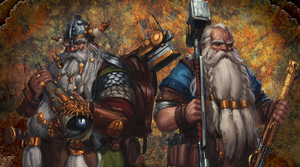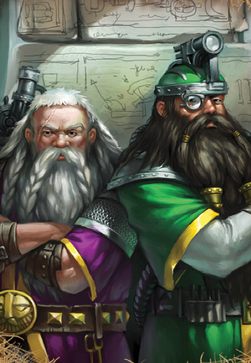"I remember my great grandfather telling me about the day the Engineers Guild discovered blackpowder. Now I'm not one to belittle the Engineers Guild even if they are a bunch of dangerously insane lunatics, but there are Dwarfs amongst them that'll have you believe that the invention of blackpowder was quite intentional. "
- —Durgrim Redmane, Longbeard

The massive Workshops of Zhufbar
The Engineers Guild is one of the most important, powerful and secretive of all the Craftsmen Guilds of the Dwarfs, whose purpose is in providing the Everlasting Realm with the latest in a long-line of technological advancements and magnificent machinery. This illustrious institution is located within the great workshops of Zhufbar, located along the shores of the massive lake known famously as Black Water. It is from here that the Guild regularly teach new and would-be Dwarf Engineers on the basic's on mathematics and standard engineering.
Most of their inventions are practical: pump to clear water from mine workings, engines to draw steel cages up vertical shafts and steam-powered drilling devices to penetrate the underworld. Since their beginning, the Engineers Guild has also developed machines for battle, war engines to wreak havoc upon their foes. Despite many technological breakthroughs, it is a conservative guild, believing proven methods are best. Innovation is frowned upon, and apprentices are taught that, ‘new ideas lead to trouble’.
Naturally, some youths oppose this mindset and tinker with outlandish inventions. Most, such as the alcohol vapour engine, come to a bad end, but a few are begrudgingly accepted. The tension between creation and tradition has caused many visionaries to be expelled from the guild, which has a number of traditional (and highly embarrassing) rites of expulsion. Some win re-admittance if their invention later wins acceptance, although typically, acknowledgement occurs long after its creator’s death. For those few Engineers, the exile is often the anvil upon which many fantastical inventions are forged.
Guild Structure
"Tradition must be respected, for it is the voice of our ancestors"
- —Dwarf proverb

Two highly respected Longbeards of the Engineers Guild
The Guild must constantly strive to balance the traditions and conservatism of dwarf culture with the inventive genius of its members. Each engineer strives to make a lasting contribution to dwarf society, to create an invention that will ensure his name is remembered forever. As a consequence, some are tempted to press through their new designs before they are properly tested and refined, or to pursue avenues of research disapproved of by their elders.
Dwarfs are a stolid and tradition-minded people, inclined to trust to the wisdom of their ancestors and their aged longbeards rather than any new ideas or innovation. Their traditionalism carries through to everything dwarfs do, including their engineering, and perhaps as a result dwarfs are the finest engineers in the world. The superlative craftsmanship of the dwarfs results in machines that not only can perform near-miraculous feats, but do so with unequalled reliability. Before a dwarf engineer submits his new design for consideration by his fellows, the nature of a Dwarf ensures that the product is in the up-most condition.
Virtually every visionary engineer has been expelled by the Engineers Guild, only to be re-admitted later on (often posthumously) after their insane invention is finally proven to work. Of course, plenty of dwarfs who only thought of themselves as visionary have been expelled, too.
Innovation
"A device for traveling rapidly up and down between deeps? What’s wrong with taking the stairs, then? In my days, we took the stairs!"
- —common criticism of a Dwarf Longbeard Engineer

A duo of sceptical Longbeards inspecting the design of a new prototype
Many of the inventions created by members of the Engineers Guild are practical, every-day sorts of items: pumps to clear water from mine shafts, steam-powered drilling devices, complex systems to draw a cage up a vertical shaft. Dwarfs can become quite well respected and honoured for creating such devices, as the benefits to dwarfen quality of life can be enormous. But somehow, there’s just not that much glory in devising a new sort of chimney flue or a way to heat water. Many engineers - the sort most likely to take up an adventuring life, certainly - hunger for something more exciting.
They want to make something showy - an invincible steam-powered warship, or a firearm that can shoot a dragon right out of the sky. In any case, creating anything new is a long and laborious process for dwarfs. First, if the engineer is to have any hope of his invention being accepted by his fellows, he must demonstrate that he has a masterful understanding of the principles of engineering - especially those principles established and espoused by the longbeards of the Guild. Since dwarfs respect age, wealth, and skill above all else, a prospective inventor would do well to ensure that he is well stocked with all three before presenting his inventions.
When he is ready (or often, long before he’s really ready), an engineer will set about designing and constructing his new invention. If he is lucky enough to have a close relationship with other engineers, he may show his plans to a few close friends and solicit their advice. More often, this is done in extreme secrecy, lest another engineer steal his idea. Once the plans are complete, the engineer builds his first prototype, potentially modifying his plans as he goes. Again, this prototype is likely subject of great secrecy and it almost certainly will not meet the very high standards of a dwarf's pride. Likely, the engineer will return to his plans, applying the lessons learned from his failed prototype to build a new one, repeating the cycle once more.
Once the device is perfect, it can be presented to the Engineers Guild for consideration, which is usually where things start to go terribly wrong. The longbeards of the Engineers Guild are infamously critical and inclined to believe that anything new is, by dint of its newness, inferior to the way things were done when they were young. They’re likely to poke, prod, mistreat, and manhandle the proposed invention, finding fault when pieces come off in their hands after only a little bit of twisting and pulling, or accusing the device of being “too rigid” if pieces don’t come off. When it comes time to actually display the device in action, they’re even more critical. The slightest irregularity in performance or perceived flaw in design is pounced upon by the senior engineers. Even when the device is perfected beyond consideration, there is always an underlying principle or concept question on why we should make such an invention, when other more practical actions can be done instead.
Still, as unbearably strict as the Engineers Guild can be, these high standards are not without their purpose. No device that can’t survive a week-long grumble from a few dozen longbeards can be expected to hold up over even a scant few centuries of use in a dwarf karak. Better any flaws be discovered now, they reason, than innocent dwarfs be injured or worse during the device’s normal operation. If flaws are found, as they almost always are, the senior engineers aren’t without mercy. They expect the device’s inventor to take the wisdom and criticism of his elders to heart and return to the drawing board. In a few decades, he might even come back with an improved, perfected version of the rejected device, and the process can begin again.
If, in the considered opinion of the Engineers Guild, the device is genuinely without flaws and performs a valuable service for dwarfkind, then the device and its creator are both celebrated for their accomplishments. Plans are disseminated and the technique for building the device is taught to a host of younger engineers, who naturally will consider their own ways of improving it. And so the cycle continues, as the once-revolutionary engineer finds himself fighting against modifications to his own design.
Expulsion
There are a number of punitive expulsion rituals practiced by the guild, including but not limited to the following examples.[3a]
- The Trouser Legs Ritual - an archaic practice of which little is known, save for the name.[3a]
- Cogging - in which the punished is stripped naked and must heft a chain of heavy cogs around the entirety of the hold's workshops.[3a]
- Blackbearding - in which the punished must use his beard to wipe down oily or soot-stained machinery, resulting in an extremely unkempt beard and abject humiliation.[3a]
- Quaffing - in which the punished must consume several gallons of oil (something only made possible by the stoutness of dwarfen constitution, as anyone else would likely be killed) and in so doing the dwarf suffers a long, painful bellyache and is unable to taste or enjoy ale or food of any description.[3a]
